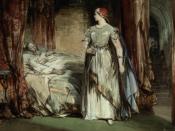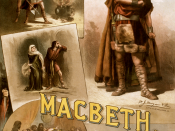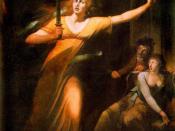Figurative Language
in
Shakespeare's Macbeth
Macbeth, the play of a greedy man who achieves his goals through treachery and murder, is filled with figurative language. Its author William Shakespeare, used imagery such as light and clothing to interpret the characters or themes. He also repeated several words as motifs throughout the play. A motif is a recurring theme in a story. One of the main motifs that Shakespeare uses is the word: blood. Blood is used forty-five times in Macbeth. It is used in many different ways with many different meanings. In this play, blood symbolizes murder, guilt, kinship, and loyalty.
Blood is mostly associated with murder in Macbeth. To become king, Macbeth murders the ruling king, Duncan. This prompts Macduff to say, "O nation miserable, with an untitled tyrant bloody-sceptered."(IV,iii) Macbeth knows how deep in murder he is in Act 3; "I am in blood, steeped so far that should I wade no more, returning were as tedious as go o'er."
Of course, blood was mentioned in the murder scene of Duncan and his guards; "Their hands and faces were all badged with blood."(II, iv) The bloodiest use of the word was when Macbeth saw Banquo's bloody ghost in Act 3." Never shake thy gory locks at me.", which describes the bloody murder of Mabeth's ex-friend.
Another use of the blood motif can be symbolized as guilt. After the murder of Duncan, Macbeth and Lady Macbeth both have a moment of guilt. Macbeth says, "Will all great Neptune's ocean wash this blood clean from my hand?" Then Lady Macbeth speaks, "Here's the smell of blood still; all the perfumes of Arabia could not sweeten this little hand." Both lines mean that Macbeth and his Lady can get niether the smell nor the stain of blood out of their hands.



Good essay
A very good concise essay which gives an excellent overall impression of Macbeth.
1 out of 1 people found this comment useful.